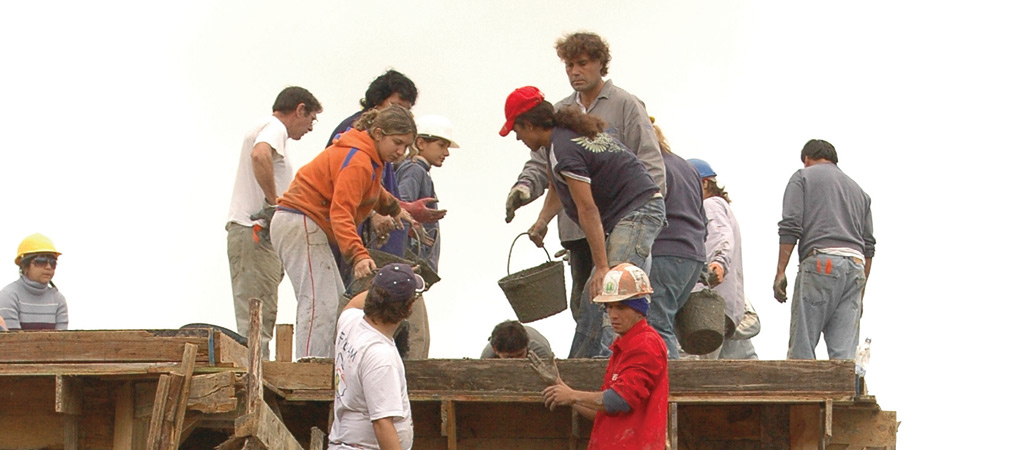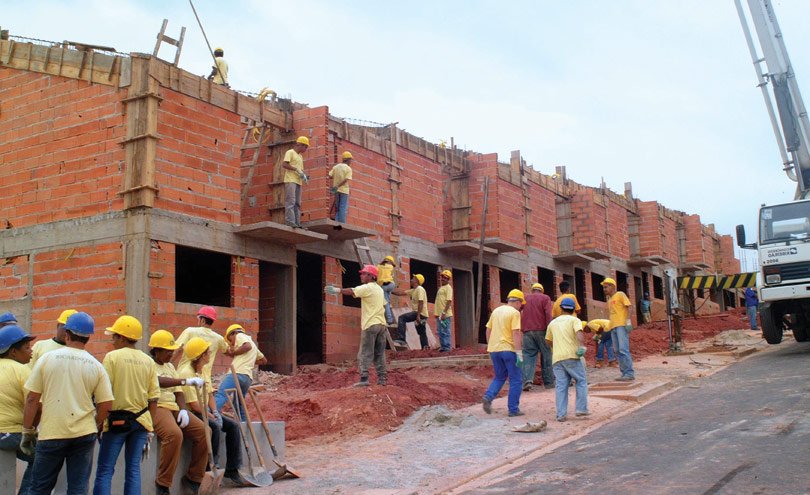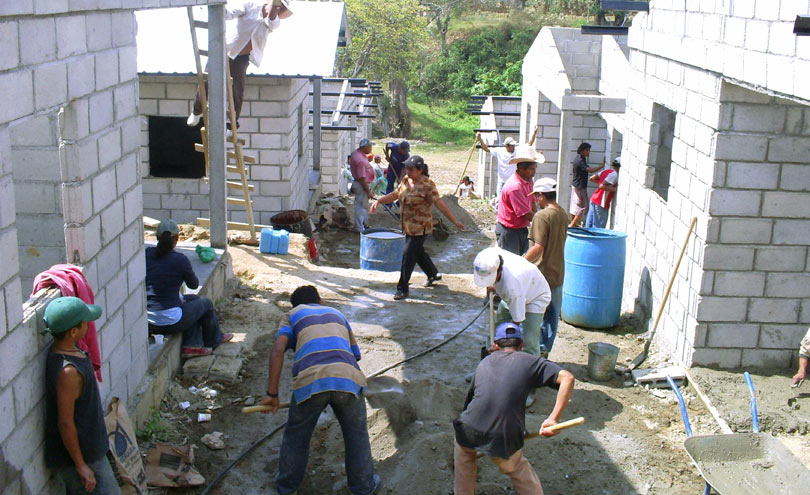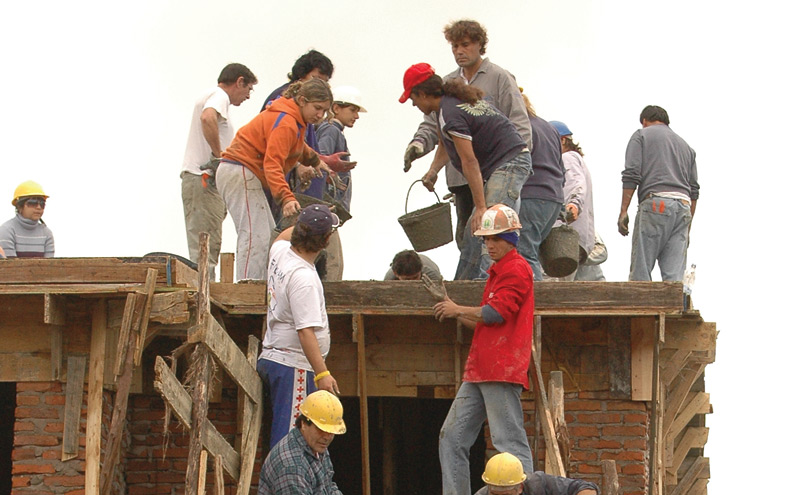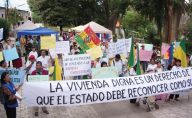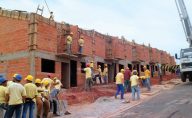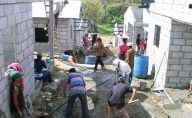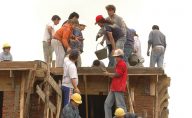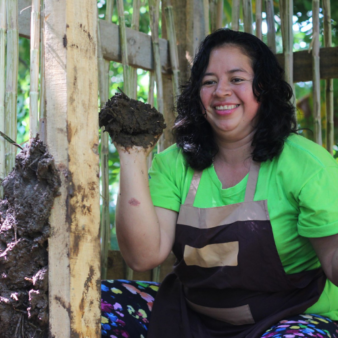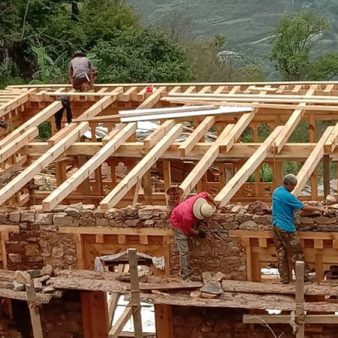Project Description
Aims and Objectives
The main objective of the initiative is to share and transfer the FUCVAM (Federación Uruguaya de Cooperativas de Vivienda por Ayuda Mutua, Uruguayan Federation of Mutual Aid Housing Co-operatives) model of mutual aid housing cooperatives to other countries where there is housing need, assist in adapting it to local conditions and support grassroots organisations in its implementation.
Context
According to UN estimates, approximately 40 per cent of families in Latin America lack access to decent housing. The region also has one of the highest rates of urbanisation in the world, and it is estimated that by 2020 the percentage of the population living in urban areas will exceed that of countries in the North. State and market solutions are often inadequate or inaccessible to low-income families, and a large proportion of the population must find its own housing solutions, usually without financial support, expertise or access to land and materials. This project aims to contribute towards addressing the critical housing need in the region by transferring a proven solution to issues faced by millions of people.
Key Features
FUCVAM is a federation of mutual aid housing cooperatives, and is the largest, oldest and most active social organisation working on issues of housing and urban development in Uruguay. The establishment of FUCVAM in 1970 was a key factor in the consolidation of mutual aid housing cooperatives pioneered in Uruguay in the late 1960’s, and from its inception has made important achievements which have contributed to the expansion of the cooperative movement both within Uruguay and in Latin America. The federation, which comprises over 500 housing cooperatives, representing more than 25,000 families in Uruguay (i.e. approximately 90,000 people), works to organise, support and train mutual aid housing cooperatives, as well as developing international partnerships.
The model developed and promoted by FUCVAM follows five key principles: 1) Solidarity – creating unity based on common responsibilities and community support to families; 2) Democratic participation – active involvement of families and democratic decision-making throughout the planning, design and implementation process; 3) Self-management – the cooperative allocates resources and directs all aspects of the project, without intermediaries; 4) Mutual aid – joint effort of every beneficiary family in the construction of all homes, each contributing ~21 hours of work per week; and 5) Collective ownership of property, providing security for families and avoiding speculation.
The South-South Cooperation project was initiated in 2001 to support the dissemination of the cooperative housing movement in Uruguay to other countries in the region and around the world. It aims to transfer the model and to collaborate in adapting it to local conditions in different contexts, helping to overcome any difficulties that arise, and developing a sustainable process with a long-term vision.
The transfer of the approach is typically carried out through a combination of (a) visits by one or two FUCVAM members to the receiving country to gain an understanding of the local needs and provide information on the cooperative approach to interested groups; (b) one or two visits/’internships’ to Uruguay by residents and technical advisors (typically 7-10 days, groups of 4-6 people) to spend time with the cooperatives and gain an in-depth understanding of the approach; (c) FUCVAM members return to the receiving country to support specific processes, e.g. technical support at the start of construction. In some cases FUCVAM members are seconded to the receiving organisations for longer periods of two to six months; (d) implementation of a pilot project and carrying out of any necessary adjustments; (e) providing support in the formulation of proposals and efforts to create the necessary financial and legal frameworks for the scaling up of the experience, taking as a reference the FUCVAM experience as well as the Uruguayan Housing Law no. 13.728 of 1968; (f) once sufficient technical and organisational capacity has been developed within the core groups, these then begin to work with other grassroots groups and technicians, spreading the knowledge more widely. The receiving groups are responsible for all decision-making, with support provided by FUCVAM throughout the process and a number of networks and federations have been set up in different countries as work has progressed.
An important factor in the success of the transfer approach is that it does not advocate replication, i.e. copying a model created in other realities and conditions. Rather, it involves a transfer of the basic principles, which should then be adapted to different contexts and appropriated by the receiving groups. The implementation of the approach therefore takes different forms; for example, the adaptation in Honduras to rural areas, when the original model is essentially urban; the creation of cooperatives in Paraguay that act on multiple fronts (housing, livelihoods, environment); the natural incorporation of collective ownership in Andean and Mesoamerican areas with strong indigenous roots and a tradition of such mechanisms; the construction of large-scale multi-family buildings in Brazil; the reuse of empty properties in Argentina and Chile, to name some examples.
With financial and logistical support from the Swedish Cooperative Centre (SCC), government agencies and local groups, as well as support from local NGOs across Latin America in constructive, economic and legal aspects, FUCVAM has successfully transferred the approach to Brazil (where the process began much sooner, in the 1970s), Paraguay, Bolivia, El Salvador, Nicaragua, Honduras and Guatemala, as well as supporting groups carrying out similar processes in Venezuela, Argentina, Chile, Ecuador, Peru, Costa Rica, Haiti and Cuba.
What impact has it had?
- The impact of the project has been significant, directly and indirectly enabling hundreds of thousands of people across Latin America to have access to decent housing as well as other opportunities for income generation and social development.
- The project has led not only to the formation of individual cooperatives but also federations and cooperative movements.
- The project has also influenced government policy, with legal and/or financial frameworks established in Nicaragua, Paraguay, Honduras and Guatemala and further proposals pending approval in El Salvador and Bolivia.
- The experience of transfer and exchange with other groups has led to improvements in FUCVAM’s own practices.
How is it funded?
The costs of the project vary from case to case and include airfares, accommodation and internal transport for the internships, as well as the development of the necessary training materials and documentation. Knowledge is shared in a spirit of cooperation and solidarity and the representatives of FUCVAM contribute their time, expertise and experience free of charge (with the exception of cases in which a member of FUCVAM is seconded to an organisation for longer periods of up to six months, in which case they are compensated for their time).
Funding for the project costs has been received from SCC, as well as from a range of other sources including local, regional and national government agencies, other organisations interested in learning from the experience and local contributions. The funding also covers the costs of the local counterpart professionals who provide technical assistance at the initial knowledge transfer and demonstration phases, after which these fees become part of the implementation costs (for which funding is obtained separately by the receiving organisations). Other administrative costs for the project are covered as part of FUCVAM’s administrative structure and management, which is funded by member contributions.
Why is it innovative?
- Simple yet effective, participatory approach, designed to ensure the long-term sustainability of the process.
- Transfer of key principles, with an approach that can be adapted to a range of different political, economic and social contexts. Technologies are adapted to each situation and appropriated by local actors, with a focus on self-management.
- The transfer is carried out with the collaboration of technical professionals, but not by and to professionals; rather it is carried out by and to residents, using appropriate instructional techniques based primarily on personal experience, learning by doing.
- The transfer process itself is adopted and transferred by others, creating a multiplier effect.
What is the environmental impact?
Whilst the focus of the approach has been primarily on social aspects, FUCVAM increasingly promotes principles of environmental sustainability, the use of local resources, renewable energy and locally-sourced building materials. In Uruguay, many cooperatives are now using earth and timber as primary building materials, as well as recycled materials from demolition sites, in contrast to the conventional use of concrete block, asbestos cement, etc.
Some of the cooperatives, each on their own initiative, have developed housing projects which use solar or wind energy, incorporate passive cooling features and/or ensure natural cross ventilation. In some countries, such as Argentina and Chile, cooperatives are bringing empty properties back into use, making use of existing resources and infrastructure and contributing to wider regeneration processes.
Is it financially sustainable?
The majority of the transfers have been carried out over the last 11 years with the ongoing support of the Swedish Cooperative Centre. Government agencies (local, regional and national) have also provided funding for the exchanges, as have other grassroots organisations across the region.
It is often the case that, having worked together to build their own housing units, cooperatives develop other activities and collective enterprises to generate income and employment (e.g. construction cooperatives) or reduce costs (e.g. collective purchasing of basic goods, childcare centres etc.). Many cooperatives also go on to build a range of community facilities and carry out infrastructure improvements.
The FUCVAM model enables a reduction of 30-40 per cent in construction costs compared to conventional housing construction. This is due primarily to the self-management process and elimination of intermediaries, as well as the local sourcing of materials and services.
What is the social impact?
Both the FUCVAM model and the South-South transfer process work to facilitate greater social integration and cooperation. All decision-making is carried out in Assemblies and residents work together and participate at all stages of the process. The process of self-management and collective production confirms the sense of belonging, increases self-esteem, provides greater security and enables residents to subsequently address other problems they may be facing.
Training is provided by FUCVAM on all aspects of the process, e.g. technical, social, legal aspects, governance etc. Residents also acquire hands-on experience in construction through the mutual aid process and FUCVAM members have gained skills and experience in training, community organising and developing adaptive capacity.
Residents are empowered to take a leading role in the process, acquiring knowledge and experience in management, construction, collective decision-making, participation in governance structures, formulation of policy proposals and generally playing a more active role in society. Many of the cooperatives focus on marginalised groups including single women heads of household, persons without fixed income, young people, persons with disabilities etc. The equal role of men and women in the construction process and governance structure reinforces the concept of gender equality, and the participation of all with the same rights and responsibilities helps erase ethnic and cultural differences.
Barriers
The main obstacles encountered include: the lack of access to serviced land and adequate funding for housing for low-income groups forming new cooperatives; the lack of enabling policy and legal frameworks in some countries; difficulties in establishing collective land ownership in some contexts; a lack of recognition on the part of some governments of the importance of people’s efforts in building cities; and a lack of technical professionals trained to work with low-income groups. These problems have been overcome with great effort, finding solutions within each particular context, providing legal and technical support, building partnerships, developing proposals, and supporting efforts to influence government policy.
Lessons Learned
- The basic principles of the model are universal and can be easily transferred, taking different forms in different contexts.
- Poor people are infinitely rich in popular knowledge, in determination and in solidarity. This allows results to be achieved that seem beyond their strength and means.
- Once the issue of access to land is resolved, half the battle is won, as people will hold on to it with all their strength.
- Experience and studies have shown that the organised social production of housing and habitat leads to much better results in terms of quality, adequacy, cost and social satisfaction, compared to conventional social housing construction in other countries in Latin America.
- Academic knowledge should be combined with popular knowledge, with a practical focus and commitment to the people.
- Solidarity that is generated from below, and then develops strong roots, produces better results than a top-down approach.
- It is important to share not only the benefits and opportunities of the model but also its challenges, as a strong level of commitment will be required from those wishing to adapt and implement the approach.
Evaluation
A participatory monitoring and evaluation process has been developed to assess the South-South Cooperation project, feeding back into existing activities and informing its future direction. Evaluations carried out by FUCVAM and SCC have found that the results achieved not only justify the continuation of the project, but also the consolidation and extension of its reach.
Transfer
The essence of the project is the international transfer of the approach to other countries in the South. FUCVAM’s South-South Cooperation project began with the transfer of the approach to government representatives and the creation of two cooperatives in Brazil in 2001, and has since expanded to cover 15 countries in Latin America. In Brazil, the transfer of the experience is highly consolidated and is being taken forward at a national scale by the União Nacional de Moradia Popular movement. In the six countries where the transfer process is being supported by the SCC (Paraguay, Bolivia, El Salvador, Nicaragua, Honduras and Guatemala), FUCVAM is currently working with nearly 7,000 families in 167 cooperatives. It is also in permanent contact with groups carrying out similar processes in eight additional countries across the region, with ongoing support and exchange.
Contacts have also been established with a number of groups in Sub-Saharan Africa wishing to learn from FUCVAM’s experience and there are plans to extend the South-South Cooperation project to the region.
In addition to transferring the FUCVAM model of mutual aid housing cooperatives to a range of grassroots groups, NGOs and government agencies across Latin America, the model of South-South transfer itself is now being transferred. Cooperatives and federations have now begun to spread the cooperative housing model and their own experiences to other groups across the region using similar transfer mechanisms. For example, FESCOVAM and FUNDASAL in El Salvador have set up similar exchanges with groups in neighbouring Central American countries as well as in Argentina, Brazil, Chile and Venezuela to transfer the approach; technicians from Brazil and groups from Paraguay who were involved in the South-South Cooperation project with FUCVAM have since contributed to the development of the Bolivian experience. The key principles are then transmitted not only from one source but from various sources, with an impact that is multiplied.

